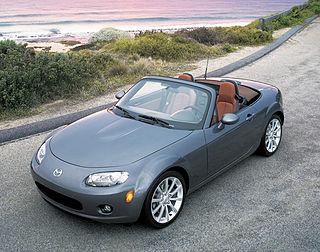
A convertible or cabriolet is a passenger car that can be driven with or without a roof in place. The methods of retracting and storing the roof vary among eras and manufacturers.

Personal luxury car is a North American car classification describing somewhat sporty, sophisticated mass-market coupés that emphasized comfort over performance. The North American manufacturers most often combined engineering, design, and marketing to develop upscale, distinctive "platform sharing" models that became highly profitable.

The North American International Auto Show (NAIAS), also known as the Detroit Auto Show as of 2022 and prior to NAIAS, is an annual auto show held in Detroit, Michigan, U.S., at Huntington Place. The show was held in January from 1989 to 2019. It was intended to move to the summer in 2020, but was canceled due to the COVID-19 pandemic that year and 2021, before returning in September 2022. It is among the largest auto shows in North America. UPI says the show is "regarded as the foremost venue for [car] manufacturers to unveil new products".

The Chrysler LeBaron, also known as the Imperial LeBaron, is a line of automobiles built by Chrysler from 1931 to 1941 and from 1955 to 1995. The model was introduced in 1931, with a body manufactured by LeBaron, and competed with other luxury cars of the era such as Lincoln and Packard. After purchasing LeBaron with its parent Briggs Manufacturing Company, Chrysler introduced the luxury make Imperial in 1955, and sold automobiles under the name Imperial LeBaron until 1975. Chrysler discontinued the Imperial brand in 1975, and reintroduced the Chrysler LeBaron in 1977 to what was then Chrysler's lowest priced model.

The Chrysler Imperial, introduced in 1926, was Chrysler's top-of-the-line vehicle for much of its history. Models were produced with the Chrysler name until 1954, after which it became a standalone brand; and again from 1990 to 1993. The company positioned the cars as a prestige marque to rival Cadillac, Continental, Lincoln, Duesenberg, Pierce Arrow, Cord, and Packard. According to Antique Automobile, "The adjective ‘imperial’ according to Webster's Dictionary means sovereign, supreme, superior or of unusual size or excellence. The word imperial thus justly befits Chrysler's highest priced model."

The Buick Roadmaster is an automobile that was built by Buick from 1936 until 1942, from 1946 until 1958, and then again from 1991 until 1996. The Roadmaster is remplaced by Invicta,LeSabre,Electra,Century and the famous Park Avenue The period is 1959-1990. Roadmasters produced between 1936 and 1958 were built on Buick's longest non-limousine wheelbase and shared their basic structure with the entry-level Cadillac Series 65, the Buick Limited, and after 1940, the Oldsmobile 98. Between 1946 and 1957 the Roadmaster served as Buick's flagship.

The General Motors Motorama was an auto show staged by GM from 1949 to 1961. These automobile extravaganzas were designed to whet public appetite and boost automobile sales with displays of fancy concept cars and other special or halo models. Motorama grew out of Alfred P. Sloan's yearly industrial luncheons at New York City's Waldorf-Astoria Hotel, beginning in 1931. They were almost invariably held in conjunction with the New York Auto Show, that for many years was held traditionally in the first week of January.

The Chicago Auto Show is held annually in February at Chicago's McCormick Place convention center. It is the largest auto show in North America.
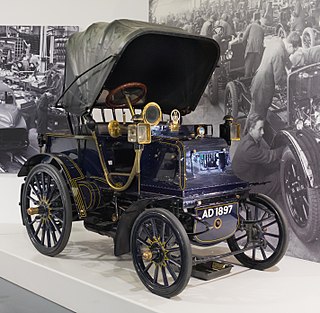
A phaeton is a style of open automobile without any fixed weather protection, which was popular from the 1900s until the 1930s. It is an automotive equivalent of the horse-drawn fast, lightweight phaeton carriage.
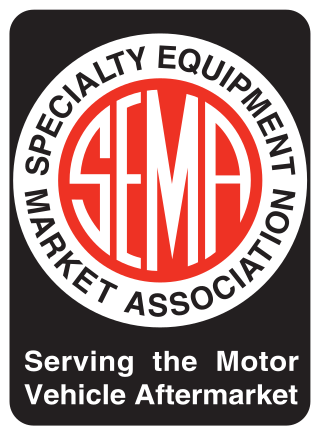
Specialty Equipment Market Association (SEMA) of the automobile aftermarket was formed in 1963 by Roy Richter, Ed Iskenderian, Els Lohn, Willie Garner, Bob Hedman, Robert E. Wyman, John Bartlett, Phil Weiand Jr, Al Segal, Dean Moon, and Vic Edelbrock Jr. and now consists of 6,383 companies worldwide, bringing together aftermarket manufacturers, original equipment manufacturers (OEM), media, car dealers, specialty equipment distributors, installers, retailers, and restoration specialists.

The Los Angeles Auto Show, also known as the LA Auto Show, is an auto show held annually at the Los Angeles Convention Center in Los Angeles, California, United States. It is open to the public for ten days, filling 760,000 square feet (71,000 m2) of exhibit space. Since 2006 the event is held in November or December.
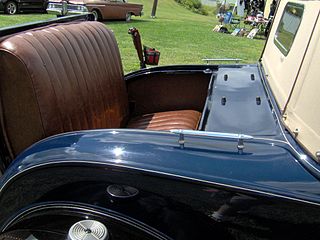
A rumble seat, dicky (dickie/dickey) seat, also called a mother-in-law seat, is an upholstered exterior seat which folded into the rear of a coach, carriage, or early motorcar. Depending on its configuration, it provided exposed seating for one or two passengers.
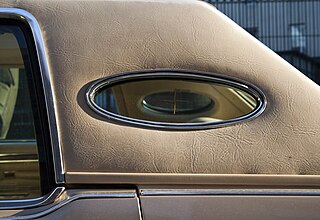
An opera window is a small fixed window usually behind the rear side window of an automobile. They are typically mounted in the C-pillar of some cars. The design feature was popular during the 1970s and early 1980s and adopted by domestic U.S. manufacturers, most often with a vinyl roof.

A ute, originally an abbreviation for "utility" or "coupé utility", is a term used in Australia and New Zealand to describe vehicles with a tonneau behind the passenger compartment, that can be driven with a regular driver's license.
Unique Whips is an American reality television show that aired on the now-defunct Speed network from 2005 to 2008. It premiered on February 8, 2005, The show follows the work of Unique Autosports, based in Long Island, New York, as they customize celebrity automobiles. It was created and Produced by Steve Hillebrand and Corey Damsker of Hollywood East. The customization generally consists of car stereo, wheels, custom paint and interior work. Celebrities whose cars were featured on the show include P. Diddy, DJ Pauly D, Jeff Gordon, Tony Stewart, Pam Anderson, Patti LaBelle, 50 Cent, LeBron James, Carmelo Anthony, Marcus Camby, Fat Joe, and Tom Wolfe.

The Western Antique Aeroplane and Automobile Museum (WAAAM) is located in Hood River, Oregon, United States, adjacent to the Ken Jernstedt Memorial Airport. WAAAM is a nonprofit 501(c)(3) organization committed to the preservation of, and education about aviation, automobile, and other historic transportation-related relics.
This is a list of automobiles produced for the general public in the North American market. They are listed in chronological order from when each model began its model year. If a model did not have continuous production, it is listed again on the model year production resumed. Concept cars and submodels are not listed unless they are themselves notable.
A retro-style automobile is a vehicle that is styled to appear like cars from previous decades. Often these cars use modern technology and production techniques.

A coupé utility is a vehicle with a passenger compartment at the front and an integrated cargo tray at the rear, with the front of the cargo bed doubling as the rear of the passenger compartment.

The Chevrolet Series AE Independence is an American vehicle manufactured by Chevrolet in 1931 to replace the 1930 Series AD Universal. Calendar year production slipped by about eight percent to 627,104 cars as the Great Depression continued, but as Ford's output plummeted by nearly two-thirds, Chevrolet reclaimed first place in the American car sales table, and the 8th million car was produced August 25, 1931. Yearly appearance changes, technical updates and standard or optional features for 1931 included the introduction of the "eagle" radiator ornament, a curved tie-bar connecting the headlights, wire- spoked wheels became standard equipment, while optional equipment listed front and rear bumpers, covers for side mounted spare tires, spotlights and guide lamps that would turn with the front tires. William S. Knudsen was joined with M. E. Coyle as General Managers. In May 1925 the Chevrolet Export Boxing plant at Bloomfield, New Jersey was repurposed from a previous owner where Knock-down kits for Chevrolet, Oakland, Oldsmobile, Buick and Cadillac passenger cars, and both Chevrolet and G. M. C. truck parts are crated and shipped by railroad to the docks at Weehawken, New Jersey for overseas GM assembly factories. Dedicated body style production continued while assignment changed from previous years based on demand.

















